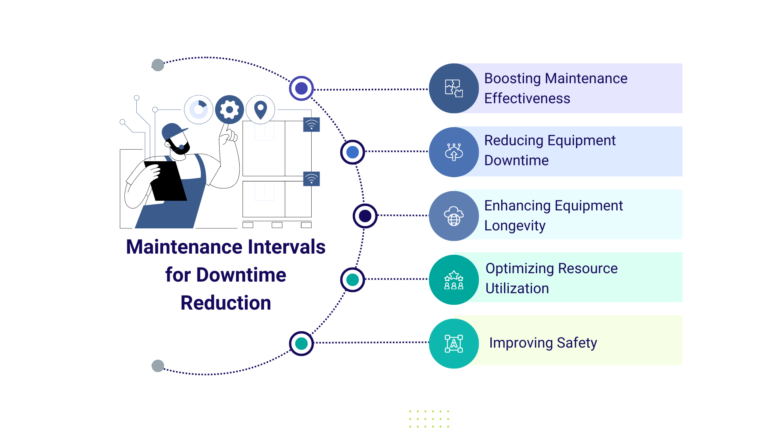Equipment uptime directly influences productivity and profitability in industrial operations.
High equipment uptime ensures that manufacturing or production processes run smoothly and continuously. This maximizes output and efficiency, allowing businesses to meet production targets and fulfill customer orders on time.
Preventive maintenance strategies involve regular, scheduled tasks to keep equipment in optimal working condition and prevent unexpected breakdowns. They are crucial for ensuring continuous equipment performance.
In this article, we will explore key strategies for maintaining equipment uptime in industrial settings, focusing on preventive maintenance and its role in optimizing performance.
Preventive maintenance is a proactive strategy designed to ensure equipment reliability and efficiency by addressing potential issues before they cause failure.
In contrast, reactive maintenance deals with problems only after they occur, often leading to more costly and disruptive outcomes
Preventive maintenance programs are designed to:
Preventive maintenance offers several benefits that enhance equipment reliability and extend the asset lifecycle.
Here are some key advantages:

To maximize equipment uptime, implementing effective preventive maintenance strategies is crucial. Here are some to consider:
Scheduled maintenance intervals are predetermined periods at which routine maintenance tasks are performed on equipment or machinery. They can:
Regular equipment inspections are based on equipment usage, manufacturer recommendations, or industry standards. They are crucial for ensuring optimal performance and longevity of assets, because they help:
A maintenance management system is a software application or platform that streamlines and optimizes the management of maintenance activities within an organization. I helps:
Data-driven decision-making in a preventive maintenance strategy involves using data and analytics to inform and optimize maintenance activities. It collects and analyzes data from various sources to make informed decisions. This can improve maintenance practices, enhance equipment reliability, and extend asset lifecycles.
With data-driven decision-making organizations can:
Setting the right maintenance intervals according to equipment usage and wear patterns is crucial for optimizing equipment performance and ensuring operational efficiency. Here’s why:
Setting intervals based on usage helps avoid unnecessary maintenance, which can lead to wasted resources and downtime. It ensures that maintenance tasks occur only when necessary, rather than on a rigid schedule that may not align with the equipment’s actual condition.

Properly timed maintenance helps prevent unexpected equipment failures, as maintenance activities happen before issues develop into major problems. This reduces unplanned downtime and ensures smoother operations.
Maintenance intervals that align with wear patterns help address issues before they cause excessive wear or damage. This extends the equipment’s operational life and reduces the frequency of costly replacements.
By considering actual needs when setting maintenance intervals, organizations can better manage maintenance resources, such as labor, spare parts, and tools. This avoids the inefficiency of performing maintenance tasks too frequently or too infrequently.
Proper maintenance intervals based on wear patterns help in identifying and addressing safety issues before they pose a risk to operators or the facility.
Regular maintenance performed at the right intervals helps meet regulatory requirements and industry standards and avoid potential fines and legal issues.
Preventive maintenance focuses on scheduled maintenance activities at regular intervals to prevent failures. Meanwhile, predictive maintenance takes a more nuanced approach by using data and analytics to anticipate equipment issues before they occur.
This enables more precise and effective scheduling of maintenance tasks, ultimately enhancing overall equipment reliability and operational efficiency.
An effective Maintenance Management System (MMS) is instrumental in improving equipment uptime. It streamlines maintenance processes, optimizes resource use, and facilitates data-driven decision-making. It can facilitate tasks, such as tracking maintenance tasks, managing assets, and scheduling repairs efficiently.
As a result, these systems enhance operational efficiency and improve overall asset management. Here’s how::
CMMS automates the creation and assignment of work orders according to scheduled or emergency needs. This ensures that your field service managers document and assign maintenance promptly.
The system records all maintenance activities, including tasks performed, parts used, and labor hours. This historical data is valuable for analyzing trends and improving maintenance practices.
CMMS provides a centralized database for all asset-related information, including specifications, location, maintenance history, and warranty details. This helps in effective asset tracking and management.
The system allows for real-time asset status tracking, including operational condition, usage, and location. This visibility supports better decision-making and resource allocation.
CMMS automates the scheduling of preventive maintenance tasks based on time intervals, usage metrics, or condition monitoring. This helps maintain equipment in good condition and prevent unexpected failures.
For systems integrated with predictive analytics, CMMS schedules maintenance based on real-time data and forecasts, ensuring that tasks are performed just before potential failures occur.
Regular equipment inspections are crucial for detecting early signs of wear and tear, which can significantly impact equipment reliability, performance, and overall operational efficiency.
Here’s why regular inspections are so important:
Implementing best practices for preventive maintenance in industrial operations can significantly enhance equipment reliability, reduce downtime, and extend asset lifespan.
Here are key best practices for effective preventive maintenance to consider integrating into your operations:
Effective preventive maintenance strategies are essential for maximizing equipment uptime, reducing costs, and ensuring operational success.
Implement a structured maintenance plan, leverage technology, train staff, optimize schedules, and analyze performance data. This will help you significantly enhance your maintenance management practices.
Schedule a FieldEquip demo to find out how it helps field service organizations achieve maximum equipment uptime through preventive and predictive maintenance strategies.
Would you like to have a free demo or have any questions about FieldEquip?
US Corporate Headquarters 1011 S. Hwy. 6, Suite 117 Houston Texas 77077 US